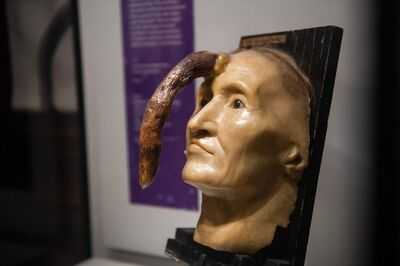Keratin plays an important role across both human and animal species, and an expert has explained the protein found in skin, hair and nails, can sometimes lead to some humans developing horns.
Dan Baumgardt, senior lecturer at the University of Bristol, said cutaneous horns, or cornu cutaneum, are compacted keratin masses that grow from a person’s skin. Their typically curved shape and hardened texture make them look like the horns of a goat, sheep or cow.
Dan told The Conversation the horns can vary in colour from yellow to brown to grey, depending on the amount of pigment and dead cells trapped within the keratin as it builds up.
- New 10-day warning for anyone taking co-codamol, paracetamol or ibuprofen
- 'My skin condition made me look like I was sunburnt - it ruined my confidence'
He said: "Cutaneous horns develop from skin lesions of various kinds, and many are harmless. Several common benign lesions such as seborrhoeic keratoses – warty swellings extremely common in older people – can develop into these 'horns'. So can other warts, including those caused by the human papilloma virus (HPV), a group of viruses that infect the skin and mucous membranes and can lead to either warts or, in rarer cases, cancer."
Around 16-20% of cutaneous horns are malignant, developing from skin cancers such as squamous cell carcinoma. This form of cancer starts in the outer layer of the skin and can invade deeper tissues if left untreated.
Others arise from premalignant conditions: skin changes that have not yet become cancerous but have the potential to do so. Dan said: "A prime example is an actinic (or solar) keratosis, which can later develop into squamous cell cancer, sometimes forming a horn but often not.
"In these cases, the cells within the lesion become denatured, losing their normal structure and function. This uncontrolled growth can lead to excessive keratin production, occasionally resulting in the formation of a horn."
Horns are far more common in older adults and in people with fair skin. They often appear on sun-exposed areas such as the head or face, suggesting that ultraviolet (UV) light plays a major role.
Dan said: "Some cutaneous horns appear in stranger places, including the chest and even the genitals. And because they can sometimes be linked to cancer, anyone who notices one should see a doctor. Their appearance can be distressing, especially when they form on visible areas like the face, and they may also cause discomfort or irritation. Treatment usually involves surgical removal of the horn and a small amount of surrounding skin, a procedure known as excision."

In 2024, an elderly woman in China made headlines because of a large horn that grew from her forehead, reaching 10 centimetres over seven years.
The record for the biggest cutaneous horn probably belongs to Madame Dimanche, also known as Widow Sunday, in the early 19th century. The French woman’s horn stretched nearly 25cm, hanging past her chin before it was removed. A wax cast of both her face and the horn are now displayed among other anatomical curiosities in the Mütter Museum in Philadelphia.
Dan said: "If you ever notice a hard, growing bump that looks even faintly horn-like, don’t wait. Get it checked by your GP in order to guide the most appropriate treatment."
You may also like

"Rahul Gandhi took out a 'Ghuspaithiya Bachao Yatra': Amit Shah

EC directs suspension of Tarn Taran SSP for "interfering with bypoll"

Jeremy Renner denies sending sexual messages to filmmaker

Bihar polls: PM Modi, HM Shah and Chirag Paswan launch blistering attack on RJD-Cong; pitch 'Jungle Raj vs Vikas' (Roundup)

Himachal Women's Commission takes cognisance of FIR against BJP MLA







